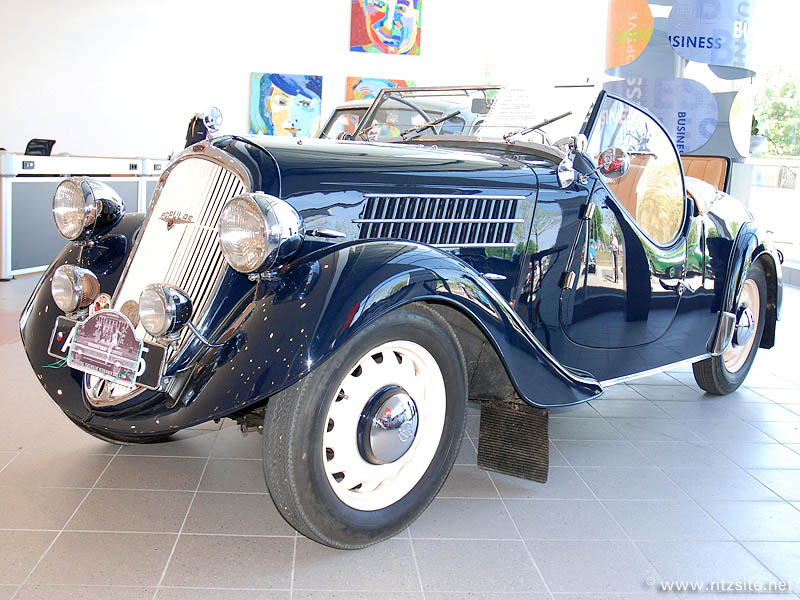|

Skoda 420 Popular - roadster body - manufactured in 1937
As last surviving of the big names in Czech car manufacture Skoda was burdened with a dubious image in the recent past. Lack of funds and an unfavorable position behind the iron curtain prohibited the once proud marque from keeping their products up to date, carrying through necessary refinements and modifications and having a satisfying quality control. This lead to a range of cars which were cheap to buy and own but also terribly outdated and unattractive. Owning a Skoda in the West meant that you were prone to be the laughingstock in your neighbourhood.
It's a good example of how a carefully forged and established reputation of decades can be reduced to nothing in a matter of years, while reestablishing a good name takes much and much longer. The Volkswagen Group can vouch for that; after the fall of the iron curtain they have taken control of Skoda car production in 1991. Radical improvements and large investments from the Germans have brought the Skoda model line up to par, but the sales value of the name still leaves much to be desired.
This is somewhat undeserved because Skoda's history has shown plenty of attractive and advanced designs which could easily compete with offerings of other European manufacturers. Car production only started in 1925, but the company had been founded as far back as 1895. It had begun as an engineering firm named after Emile Skoda and it made a fortune producing armaments during World War I. After the war the company turned to all sorts of industrial production, like trains, ships, power stations and much more. One of these ventures became car manufacture. Established manufacturer Laurin & Klement (also founded in 1895) was merged into the combine and from 1925 their cars carried the Skoda name. Skoda also acquired rights to produce Hispano-Suiza models and these were big, stately cars for the wealthy.
A wide range of models with 4, 6 and even 8 cylinder engines followed and these not only found customers on the home market but were also exported to countries like Germany and Austria. In the 1930s, after the recession, Skoda rationalized its car production and introduced a unitary design concept based on a backbone chassis with independent rear suspension by swing axles. The first of these models was introduced in 1933 as the 420 Standard; a small car with a 1-litre 4-cylinder side-valve engine which produced only 20 hp but propelled the 750 kg light car to 80 kph. It was soon followed by the 420 Rapid with a 1.2-litre engine and 26 hp. The most successful model however was aptly named 420 Popular. This model appeared in 1934 and had a 22 hp version of the 1-litre engine.
The Popular was very affordable, economical and practical and found an enthusiastic market in the whole of Europe and beyond. It was regarded as a trend-setting design and similar models of other manufacturers followed. There was a variety of body styles available for the Popular: sedan, coupe (with aluminum bodywork), roadster, coupe-cabriolet, cabriolet and van. The coupe was extremely rare with only 20 produced, and also the roadster, shown here, wasn't very common. Just a few hundred were made of this characteristic shape with its low-cut doors, and just a handful remain. Production of the 420 Popular ended in 1938, but the line was continued with updated and modernized versions like the 1100 OHV and 1101 which carried the Popular name well into the 1940s. After World War II the Popular model name was dropped yet its design lived on, with revisions, until it ended in 1952 with the 1102 model.
Alongside the Popular there were larger and more luxurious models offered by Skoda based on a similar backbone chassis and swing axle rear suspension lay-out, like the Favorit and the Superb; it was the Popular however which familiarized the Skoda name abroad and gave a good ring to it. In the 1950s and 1960s this was continued by the Octavia and Felicia models, which were appealing and reliable middle class models. It was the rear-engined 1000 MB from 1964 which changed things. Though a modern car at the time of its introduction it was produced until way beyond its shelf life (up to 1990) with later quality problems and ill conceived esthetic revisions to make matters worse.
And now its up the Volkswagen Group to polish up the tarnished name. One of the methods used is to refer back to Skoda models of old like the Popular by displaying them at car shows and events, hoping to increase credibility and awareness of the Skoda name. This way also the memory is kept alive of the fact that Eastern Europe has enjoyed a lively history in car manufacture as well, right from the early days.
© André Ritzinger, Amsterdam, Holland
|
